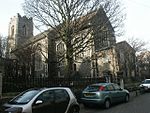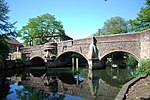Norwich railway station

Norwich railway station (formerly Norwich Thorpe) is the northern terminus of the Great Eastern Main Line in the East of England, serving the city of Norwich, Norfolk. It is 114 miles 77 chains (185.0 km) down the main line (measured via Ipswich) from London Liverpool Street, the western terminus.It is also the terminus of numerous secondary lines: the Breckland Line to Cambridge; the Bittern Line to Sheringham; and the Wherry Lines to Great Yarmouth and Lowestoft. The station is currently managed by Greater Anglia, which also operates the majority of the trains that serve the station. East Midlands Railway operates the services to Liverpool Lime Street via Nottingham, Sheffield and Manchester Piccadilly.
Excerpt from the Wikipedia article Norwich railway station (License: CC BY-SA 3.0, Authors, Images).Norwich railway station
Station Approach, Norwich Thorpe Hamlet
Geographical coordinates (GPS) Address Nearby Places Show on map
Geographical coordinates (GPS)
| Latitude | Longitude |
|---|---|
| N 52.6269 ° | E 1.3065 ° |
Address
Norwich Railway Station
Station Approach
NR1 1EF Norwich, Thorpe Hamlet
England, United Kingdom
Open on Google Maps








